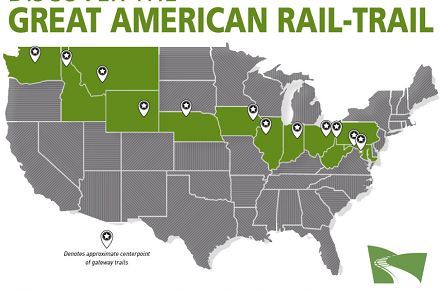

The Rails-to-Trails Conservancy (RTC, the largest trails organization in the U.S.) recently announced its vision for the Great American Rail-Trail, designed to connect nearly 4,000 miles of rail-trail and other multi-use trails from Washington, DC, to Washington State.
The concept, which RTC is calling “an unprecedented commitment to creating an iconic piece of American infrastructure,” was 18 months in the making as organizers analyzed possible routes and existing trails and came up with one overall route that would link together many of them.
The Great American Rail-Trail would allow users to, in the words of RTC, “experience the diversity of America’s landscape, its people and its places as the route traverses 12 states moving west from its start in Washington, D.C. “
While the full route for the trail won’t be released until spring 2019, RTC has revealed the 12 gateway trails that make the Great American Rail-Trail possible:
Capital Crescent Trail, Washington, D.C., and Maryland: This 11-mile trail—and the Great American Rail-Trail—begins in Georgetown, near the historic landmarks of the nation’s capital.
Chesapeake & Ohio Canal National Historical Park, Washington, D.C., and Maryland: The nearly 185-mile trail connects Washington, D.C., to Cumberland, Maryland, featuring canal locks, lock houses, aqueducts and their canal structures.
Panhandle Trail, Pennsylvania and West Virginia: The 29-mile trail heads west from the Pittsburgh suburbs into northern West Virginia, serving as a literal gateway between the states.
Ohio to Erie Trail, Ohio: The 270-mile trail cuts diagonally across the state, connecting two major waterways, the Ohio River in Cincinnati and Lake Erie in Cleveland.
Cardinal Greenway, Indiana: RTC’s 2018 Rail-Trail Hall of Fame inductee stretches northwest for 61-miles through rural Indiana, making it the longest rail-trail in the state.
Hennepin Canal Parkway, Illinois: The 100-mile-plus trail parallels the early-20th-century canal and runs west from the Illinois River to the Rock River.
Cedar Valley Nature Trail, Iowa: This 52-mile pathway, one of the first rail-trail conversions in the state, follows the Cedar River and connects Waterloo, Cedar Falls and Cedar Rapids.
Cowboy Recreation and Nature Trail, Nebraska: One of the longest rail-trails in the country, this 219-mile trail traverses rural Nebraska, connecting small towns and offering views of the High Plains.
Casper Rail Trail, Wyoming: This 6-mile trail is an important connector in one of the largest cities in Wyoming.
Headwaters Trail System, Montana: The nearly 12-mile trail connects to Missouri Headwaters State Park, where three rivers meet to form the Missouri River: the Jefferson, Madison and Gallatin.
Trail of the Coeur d’Alenes, Idaho: This nearly 72-mile trail runs through Idaho’s panhandle, delivering breathtaking vistas through the state’s forests.
Palouse to Cascades State Park Trail, Washington: Another of the nation’s longest rail-trail conversions, this trail spans more than 200 miles across Washington and marks the terminus of the Great American Rail-Trail.
Sports event owners should know that a coast-to-coast challenge – without the risk of traffic – could bring in a variety of users, including those interested in sightseeing, challenging themselves (and possibly others) and of course, posting their various locations to social media. In this sense, it has the potential to become a venue similar to the Appalachian Trail and Pacific Crest Trail, only with accessibility to a wider range of athletes.
“At RTC, we’ve known the potential of a coast-to-coast rail-trail for decades,” said Keith Laughlin, RTC president. “But before we committed to bringing this vision to life, we wanted to be certain it was viable. With open trails comprising more than 50 percent of the potential route, combined with strong local and state enthusiasm, we are now confident that the Great American Rail-Trail can be completed. RTC is ready to lead the effort to connect the trail across communities, counties and state lines to create a seamless off-road biking and walking journey for the country.”
It is, however, a long-range goal, he notes, calling it “a bold vision — one that will take years to complete.” It would also be the single largest trail project in the history of the U.S.
The Great American Rail-Trail is a signature project of RTC and the most ambitious in its portfolio of TrailNation™ projects — the organization’s initiative to encourage the rapid replication of regional trail networks across the country. The trail was first envisioned in the late 1980s by RTC co-founder David Burwell, and for decades has been an underpinning of the organization’s strategy to create a nationwide network of public trails.
More information about the project, including a more specific route, is to be announced in the spring.
It is likely the project will face multiple challenges including not only the expected obstacles of funding and the actual work of creating an infrastructure that would string together trails in a traffic-free manner, but the resistance of some community members who view trails as potentially troublesome venues. The so-called NIMBY (Not In My Backyard) element has presented problems when communities want to convert out-of-use rail lines and other pathways to recreational facilities.
More information about the Great American Rail-Trail is expected to be available on greatamericanrailtrail.org as the project progresses.

